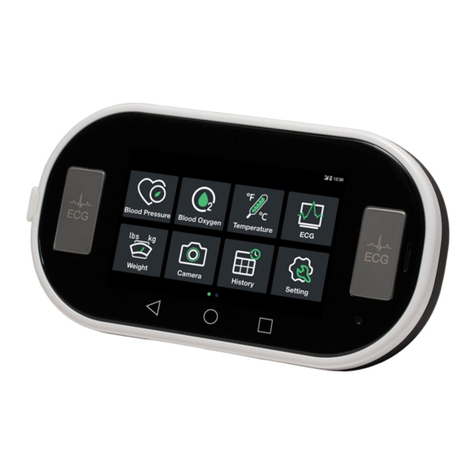
3
05 MEASURING BLOOD OXYGEN (SPO2) 42
05.1 Overview 42
05.2 Safety Information 44
05.3 Display & Symbols Bank 46
05.4 Taking A Reading 47
05.5 If Using Oxygen 49
05.6 Illustrated Example of Measuring
Blood Oxygen Saturation 51
05.7 Troubleshooting 52
06 MEASURING FOREHEAD TEMPERATURE 53
06.1 Overview 53
06.2 Safety Information 53
06.3 Display & Symbols Bank 54
06.4 Taking A Reading 55
06.5 Illustrated Example of Measuring
Forehead Temperature 56
06.6 Troubleshooting 57
07 ECG SCANNING & RECORDING 58
07.1 Overview 58
07.2 Safety Information 58
07.3 Display & Symbols Bank 60
07.4 Taking A Reading 61
07.5 Illustrated Example of Measuring ECG 63
07.6 Troubleshooting 63
08 MEASURING and STORING
WEIGHT & HEIGHT 64
08.1 Overview of Manual Process 64
08.2 Manual Display & Symbols bank 64
08.3 Manual Height & Weight 64
08.4 Illustrated Example of
Manually Storing Height 66
08.5 Illustrated Example of Manually
Storing Weight 66
08.6 Troubleshooting 67
08.7 Overview of Measuring Weight
using a Bluetooth Weight Scale 67
08.8 Measuring Weight using a
Bluetooth Weight Scale 68
09 STORING BLOOD GLUCOSE 70
09.1 Overview of Manual Process 70
09.2 Manual Display & Symbols bank 70
09.3 Manual Blood Glucose 71
09.4 Illustrated Example of
Manually Storing Blood Glucose Data 72
09.5 Troubleshooting 73
10 CAMERA 74
10.1 Overview 74
10.2 Display & Symbols Bank 74
10.3 Illustrated Example of Taking
a Picture and Adding in Comments 74
11 AFTER MEASURING 75
11.1 Measurement Processing 75
11.2 View the Measuring Result 75
11.3 Display & Symbols Bank 76
11.4 Check the History 76
12 INTRODUCE 78
13 MODE SWITCHING 78
14 CLEANING & DISINFECTING 79
14.1 The Difference between Cleaning &
Disinfecting 79
14.2 Safety Information 79
14.3 How to Clean the Device 80
14.4 How to Disinfect the Device 83
14.5 Approved Cleaning & Disinfecting Product 84
14.6 How to Clean & Disinfect the Arm Cuff 84
15 STORAGE &MAINTENANCE 85
15.1 Storage 85
15.2 Safety Information 86
15.3 Maintenance 87
15.4 Discarding 87
16 SPECIFICATIONS 88
17 LIMITED WARRANTY 90
17.1 Manufacturer's Warranty 90
17.2 Limitations of Warranty 90
17.3 User Responsibility 91
17.4 What's NOT Covered by Warranty 92
17.5 Precautions for Transfer and Disposal 92
17.6 End User License Agreement for Software 93
18 COMPLIED STANDARDS LIST 94
19 IEC60601-1-2 EMC & RF STATEMENT 96
IMPORTANT INFORMATION REGARDING
ELECTRO MAGNETIC COMPATIBILITY (EMC) 96
GUIDANCE & MANUFACTURER'S
DECLARATION 97





































